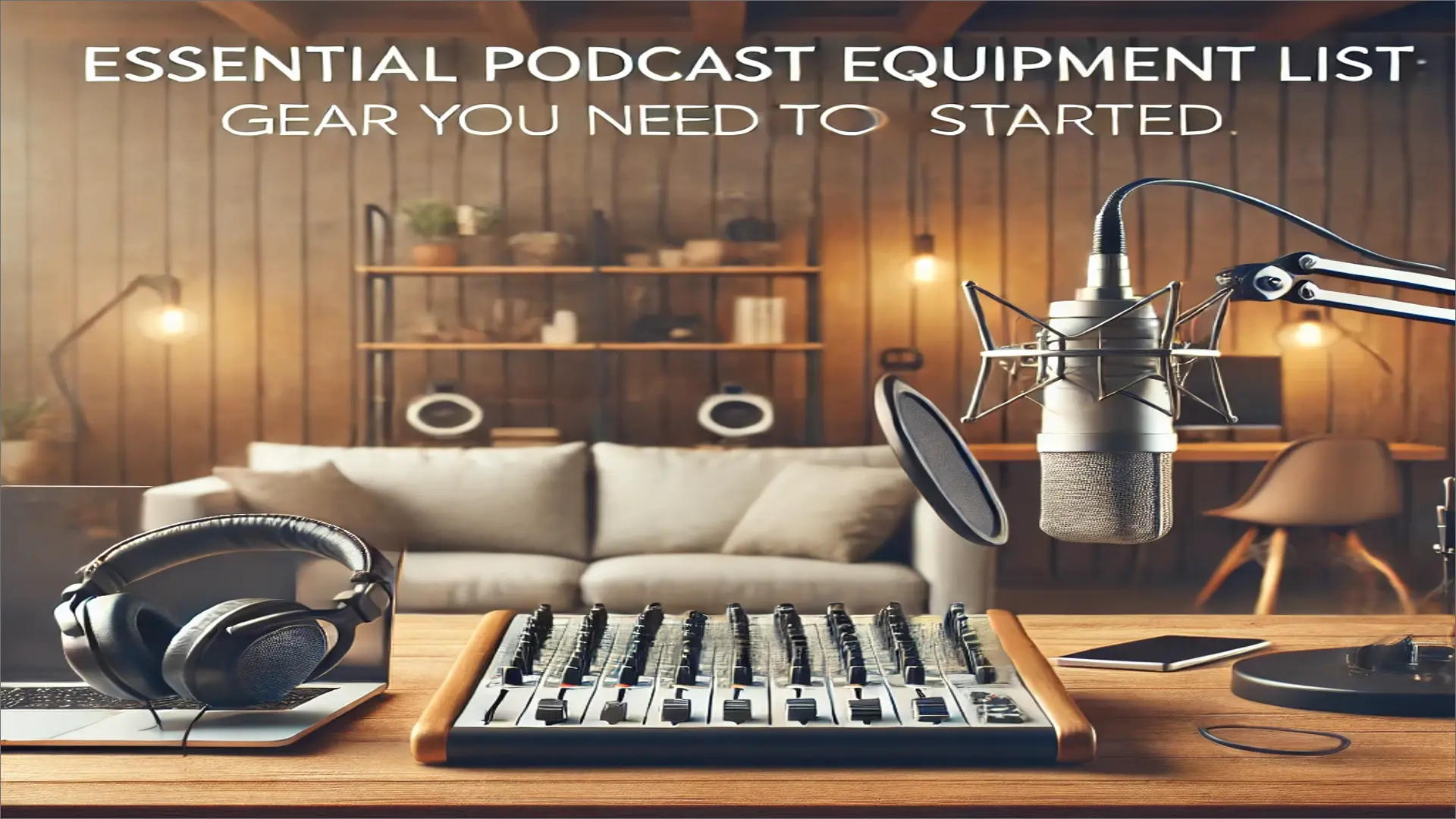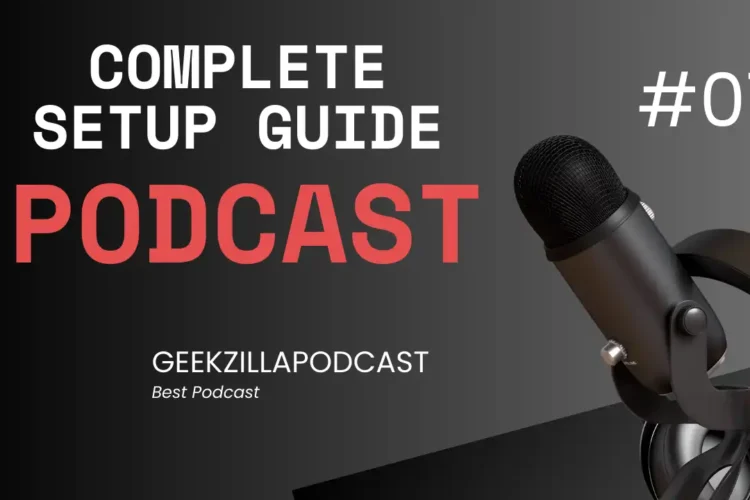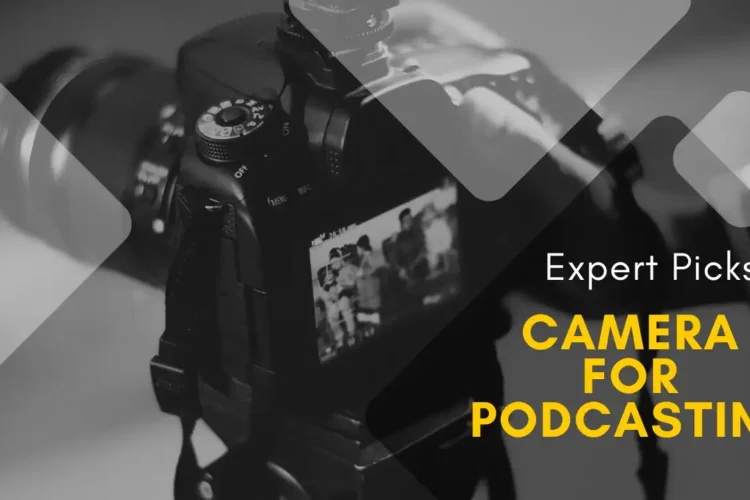
Are you looking for recommendations for excellent podcast equipment? Do you want to know what gear you should get to begin with? Well, this is good news; whatever your situation, whether you’re starting and looking for ideas on how to design your podcasting setup or a well-seasoned podcaster who wants to take their studio to the next level, you will find great ideas below.
But first, let me focus on something…!
Why Such Concern About Podcast Equipment?
Well, technically, yes. But then again, it might not be enough if you wish to create a great-sounding and do not want to scare potential readers away because of the gruesome audio and non-entertaining production. Thus, great emphasis is placed on selecting the proper tools.
Podcast Equipment And Setup
These terms embrace a broad range of gears and other accessories that tick the box for a well-sounding room. One can easily picture a radio studio at a professional level containing lots and lots of scary (and very pricey) gear. But for most creators, it does not even resemble their equipment arrangement.
Equipment can be categorized depending on the process of recording the voice, and that includes but is not limited to, a Microphone, Mixer, and Recorder. In this guide, we’ll help you through a microphone, shock mount picks, and recording software for affordability.
What is the Minimum Equipment That Is Required For Podcasting?
To begin with, we recommend you start with the following equipment:
- Microphone(s)
- Headphone(s)
- Recording device or computer
- Multitracking /recording/editing software, also known as Digital Audio Workstation (DAW)
- A camera (if recording video)
Other recommended, but not vital, and gear include:
- Any interface or mixer for audio signals.
- A pop filter
- Lighting
- A Mic Arm
- A shock mount
i. Headphones With Mic
This may be convenient if you do not want to prompt feedback by connecting a mic and instead opt for headphones. In this way, you are also becoming more aware of quality assurance. One advantage of this piece of equipment necessary for any show is that it allows you to hear your voice more clearly. It also eliminates problems such as echo and bleed-through on the audio end of the communications. Thus, it gives you more control over the volume and pitch of your voice as you record a particular segment.
It is essential to use headphones when recording since it is one of the critical aspects of producing a high-quality podcast. Headphones also help you improve your microphone technique and filter out plosive sounds, especially the letters “p” and “k.” Plosives are horrible to remove and quite annoying.
When purchasing headphones, keep the following specifications in mind: When purchasing headphones, keep the following specifications in mind:
- Frequency Response
- Sound Isolation
- Impedance
- Sensitivity
- Comfort
- Portability
- Price
The audio quality of incredible microphones can’t compare with the audio from some average microphones. Never depend on the laptop or even the built-in phone mike to create a show. If you do that, you will have multiple direct and poor-quality sounds.
You may be asking yourself, ‘What is the best microphone?’ We have two types of microphones on our list of necessities. The first includes one that utilizes a USB link. A USB microphone simply requires you to plug it into your laptop’s USB port. The second is a more professional type of microphone connected to XLR. This connects your microphone to a professional audio interface, recorder, or mixer, which then interfaces with your laptop.
ii. USB Microphone
Inexperienced people will typically set up their studios with the help of a technician, but they will do it themselves. If this is you, you should go for a USB microphone. It is also easy to install and operate. Secondly, USB microphones are particularly suitable for podcasters who create content in a storytelling or narrative style. They give decent audio quality, nothing more than that when compared to professional studio microphones.
A. XLR Microphone
However, you will need a few additional things to use an XLR microphone. Here, the XLR connector is relatively more advanced than the USB connector. It will, however, create higher-quality sound than USB devices, which have become more common in recent years. It is similarly beneficial in cases where you require utilizing a large number of microphones concurrently. For podcasting, this means being in the same physical location as your co-hosts or guests.
Before buying a microphone, ensure it is compatible with your laptop. You can connect it to your device in two ways.
B. Microphone Arm
Both you and your hosts do not want to be consumed holding your microphones for the entire duration of your recording. An arm is one of the most accessible accessories, which are necessary for podcasting. It just allegedly supports your microphone. You still want a good arm so you can rely on it to hold the mic steady, giving you a good arm. Another advantage of using an arm is that it also cuts out other sounds and even changes in volume created by the movement of the microphone.
iii. Podcast Starter Kit Setups
Here are the three setups we’ll take a look at:
A. The Smartphone Starter Kit
This is a more accessible and cheaper solution for recording solo shows or local (on-location) co-hosts and guests.
B. The USB Mic Starter Kit Online
The most preferred technique is capturing solo shows or online co-hosts and guests.
C. Podcast Kit for All-Rounder Personality
Lastly, we turn to the fourth and final setup that can be efficiently used in practice. It may be slightly pricier, but your choices, mobility and acoustic quality will be elevated to a different level.
iv. Audio Interface
An audio interface is a device that allows you to connect your equipment and your computer. It takes your recorded talking into a digital format that your computer can understand. This is useful if you use XLR microphones or in a multiple-speaker recording scenario where you want to create individual tracks. However, it won’t be necessary if you don’t plan on moving the mic around (mainly if you’re using a USB mic), but it can assist in the recording process.
What to Consider:
Inputs: Ensure a proper input connection for your headphones and mics.
A. Audio Mixer
To a certain extent, a mixer is not indeed deemed a podcast requisite for flexible equipment. However, you may want to use one if your show involves several hosts or guests. They are also helpful for capturing several types of sounds.
Therefore, it is also essential to consider the number of channels a mixer can handle. Ensure it has built-in preamps and determine if it integrates well with other equipment.
B. Vocal Recording And Editing Software
Besides the recorder and the computer, editing tools are also essential. Recording software produces high-quality audio from microphones and all other equipment used during the recording. To record sound, you also need digital audio workstation (DAW) software to compile different clips into podcast shows. Plus, you can add the sound effects and soundtrack, adjust the pitch and balance the sound from various sources with the DAW. When choosing the podcast recording and editing software, it is essential to ensure that you opt for one that supports your computer operating system.
Despite that, many people who invest their time in podcasting often ask, ‘How do these shows generate income, though I am just beginning this practice and am yet to earn from this venture? Successful shows advertise and generate sponsorship revenue. Some advertisers may also guide the listeners to their merchandising stores. Before, during, and after monetizing, a podcaster must learn to use recording and editing software to splice ads or insert sponsors’ messages into episodes.
What is a USB Audio Interface?
A USB audio interface is a small device to which one can connect an XLR mic on one side, at least ideally. Some models may have sockets into which you can plug more than one XLR mic.
A USB audio interface requires a connection to your computer, which is done through a USB port. In a way, this is rather amusing. It affords you way more control and options than that standard rig with a USB microphone.
You would also connect your headphones to the USB audio interface and prepare for the recording or mixing process. Eventually, it becomes your input and output, or what is often referred to as I/O. You just have to choose these two options when adjusting some preferences.
Podcast Audio Interface
Not all audio interfaces are USB, however. As it turns out, ‘interface’ encompasses a large category, and audio interfaces run the gamut. As a device, there is your computer’s internal sound card. USB dongles], for example, can be as small as a few millimetres in size. There is the circuit that comes with the USB microphone. Then there are breakout devices varying from a USB interface with microphone input to more gigantic interface rack forms used in many studios today.
Some podcasters record using their smart devices, but the result does not sound very smart. Some people use a USB microphone, which is a step further in the right way. However, if one is serious about getting a professional sound, then he or she will have to invest in a good audio interface.
Here are some of the best ones.
- Focusrite Vocaster Two
- Presonus audio box USB 96 25th anniversary edition
- PreSonus Revelator io24
- Universal Audio Apollo Twin X DUO Heritage Edition is aimed at music producers and musicians.
- Zoom H6 All Black
- Focusrite Scarlett 2i2
- RODE RODECaster Pro II
- RODE RodeCaster Duo
- Mackie DLZ Creator XS
- Lewitt Connect 6 and Connect 2 Similarities
Equipment Summary
Like any other show, the first steps to podcasting involve buying the perfect equipment set. Some people may be willing to pay more for a microphone, while others may specifically want a high-end DAW in post-production.
Fortunately, there are no satisfactory answers. Everyone’s starter kit should be different because what you want from podcasts and what you will offer to them is individual.
Yes, there exists the perfect set of equipment depending on your budget, starting from $20 and going up to $500.
FAQ’s- Podcast Equipment
What Equipment Is Needed for a Podcast?
You will need a microphone or microphones, headphones or headphones, and a recording and editing suite for a podcaster’s setup.
If you plan on making video recordings, you may need more accessories, like a boom arm or a microphone stand, a mixer, a pop filter, additional lighting, and a camera.
Is It Challenging to Build Podcasting Equipment?
Arranging the necessary equipment for recording the podcasts may be quite daunting, at least for first-timers, but that should not make one sweat!
What does one need to launch a podcast?
- Microphone
- Headphones
Audio recording and editing software is an application used to capture and manipulate these sounds.
- A quiet space
- A hosting platform
Is it possible to begin podcasting with no equipment at all?
Creating a video for free is doable with these steps: Your next step is to plan your videos and create a free account on YouTube. You can record your show through a video-recording device such as a Smartphone or webcam. You edit your podcast using a free video editing tool and then publish it to YouTube.
Is it possible to have 3 hosts for a podcast?
Typically, political and cultural talk shows have two or three hosts, which feels like listening to the two hosts Gang up. For instance, consider the Pod Save America or My Favorite Murder.
Read More : Best Podcast Making Apps to Make Podcasting Simple in 2024
Read More : Podcast Mystery: Promotion Profit And Purpose of Podcasts


